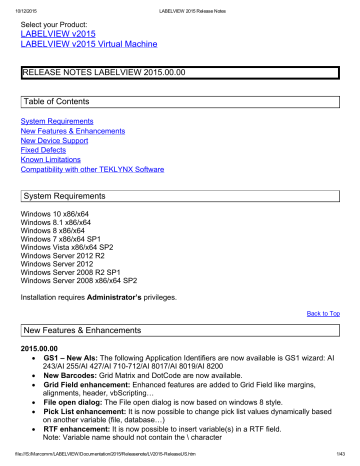
#Automating labelview manual#
Watch the video to learn how:Ĭustomized label printing forms turn manual data entry from a difficult, time-consuming task to a quick and low-effort way to get accurate print-time data onto your label. If you’ve been using the default print form for When Printed fields, you can easily convert the default print form to a custom print form, select the proper settings, and instantly gain efficiency. In LABELVIEW and CODESOFT 2021, we’ve made it even easier to create a custom label print form. You can also place data validation on the field, such as forcing a phone number to be in a specific format or only allowing a maximum of 10 characters. In LABELVIEW and CODESOFT, label print forms can be completely customized to create your ideal label printing process.Ĭustom label print forms offer a wide variety of field options: text, incrementing numbers, sliders, date pickers, and more. When manual data entry at print time is truly unavoidable, you can leverage custom label print forms to make data entry easy and accurate. Even better, it reduces the risk for labeling errors that can cause expensive delays or rejected shipments. This saves time for your print user, allowing them to get back to other value-added work. With database connections, your user can simply select the relevant database record at print time. You can then toggle through the records and watch the data change. Then, click and drag those fields onto the label as text, barcodes, or images. Simply select your database, select your table, and choose the fields you want to use on your label.
#Automating labelview software#
Whether your database is a spreadsheet such as Excel, Excel Online, or Google Sheets, or it’s a Microsoft Access database, or it’s part of your business system like Oracle or SAP, your labeling software can create a connection to that database.Ĭreating a database connection is easy, and there’s even a wizard for it in LABELVIEW and CODESOFT. Instead of forcing your print users to key in data at print time (and hoping they don’t make a mistake!), you can connect your label template to your business database. Extra work is precisely what you want to avoid when you’re understaffed! Luckily, there’s a better way. In reality, relying on When Printed fields burdens your print users with extra work and leaves your labels vulnerable to manual errors. The print user keys in the correct data and prints the label. A When Printed field is simply a form that is presented at print time. The most basic method of data input is a When Printed field. Once you’ve created your label, you must create a way to get the proper data onto it. Connect your database to your label template All that time saved can be dedicated to different value-added activities.

Using built-in wizards in your label design software not only saves time for you and your users, it also ensures that your objects are created accurately and reduces the need for additional edits. You can even easily generate GS1 barcodes using the GS1 barcode wizard. LABELVIEW and CODESOFT offer new label wizards to help set up your label template, as well as text, image, and barcode wizards. It also includes a helpful wizard for adding printers. LABEL MATRIX barcode label design software includes a text object wizard, an image wizard, and a barcode wizard to assist in placing objects onto your label. Built-in wizards walk you through each step of adding text, barcodes, or images, helping you to get it right the first time. When you need to design new labels or generate new barcodes, use helpful wizards to make the process quicker and easier. When your company faces labor shortages, here are seven key ways to make labeling less manual so your staff can focus on other value-added activities.

While labeling is absolutely a critical business function, it doesn’t need to use up valuable person-hours. When labor shortages happen, but consumers continue to want their products quickly, companies are forced to focus their resources on the most critical areas of their business. csv ( 'repos-users-dump.Originally appeared on The Human Readable Blog, by TEKLYNX.


 0 kommentar(er)
0 kommentar(er)
